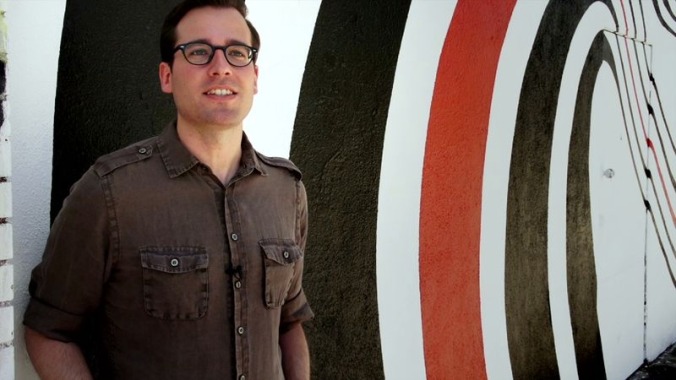Reading the news about Elliott Smith’s death is one of those memories my mind has granted total recall and clarity. Of the brain-clutter gathered in nearly 30 years on this Earth, only a few memories stand out like this: meeting my wife, getting a phone call from Sean O’Neal asking if I’d like to work for the Austin outpost of The A.V. Club, the deaths of people I actually knew, and sitting in front of a bulky laptop in my freshman-year dorm room, discovering (from the front page of weezer.com, of all places) that a musician who had l was just growing to love was no longer among us.
What happened next is also forever stuck in my head: a sour feeling in my stomach, and then the impulse to rush to the campus record store, Flat, Black, And Circular, to pick up “Pretty (Ugly Before)” b/w “A Distorted Reality Is Now A Necessity To Be Free,” the last piece of Smith’s music he lived to see released. I’d passed it over while combing through the 7-inches a few days before, and I hoped like crazy that no one else had bought it in the interim—or heard the news and had the same impulse I had. Fortunately, it was in the same spot I’d left it, the paper-cutout-skyline of its sleeve resting against other singles that just weren’t as important at the time. The single was a reminder that while people flit in and out of our lives, they leave pieces of themselves to be remembered by.
And Elliott Smith left behind a lot of himself in his songs, a confessional body of work with a Beatles-esque tunefulness and an emotional openness that attracted listeners who mapped their own sorrows onto “Say Yes” or found a kindred spirit in “Somebody That I Used To Know.” The album that contains the latter song, 2000’s Figure 8, also gave Smith’s fans a way to memorialize the fallen musician, thanks to its cover photo. The swooping backdrop of that image—shot by rock photographer Autumn De Wilde—is a fixture of Smith’s adopted hometown, Los Angeles, a mural leading the residents of Silver Lake to the front door of Solutions!, an all-purpose audio, video, and electronics shop on Sunset Boulevard.
According to Anji Williams, founder of local outreach group Punk Rock Marthas, Smith fans began affixing temporary tributes to the mural shortly after his death—though as is the case with other de facto rock monuments like the brick wall outside Abbey Road Studios or Jim Morrison’s grave, the notes of thanks and appreciation eventually grew more permanent. Plagued by graffiti—and at one point hijacked by a viral-marketing campaign for Roger Waters’ live performances of Pink Floyd’s The Wall—the mural has required multiple restorations in the decade since Smith’s death, including one intentionally fleeting redux overseen by Williams and Punk Rock Marthas, which coated the painting’s stripes in scrawled lyrics, messages from fans, and a flock of paper cranes.
When The A.V. Club visited Solutions!, owner Stephon Lew had recently given the wall a fresh coat of paint, its whites crisp and clean, the stripes leading to vivid blobs of red and black on the sidewalk. Yet there’s still a poignancy to the fact that so many fans had previously left their own impression on the wall—much as Smith’s music has left an impression on them. In an e-mail sent prior to The A.V. Club’s visit, Lew mentioned his wish that the mural be viewed not as a wailing wall, but rather a celebration of Smith’s life and work. Standing in front of the mural’s refreshed form, feeling as if De Wilde and Smith could set up camp in front of the swirl at any moment, it’s easy to fulfill that wish.
Like Smith’s music, the wall is an understated, direct work of art. And it too can be read like a Rorschach ink blot, made out to be lines on a piece of sheet music or winding bits of circuitry—the red ones representing love, passion, or blood. Take a look at it from across the street, and it’s simply a big “S”—as in “Solutions!” or “Stephon.” Or, in light of the musician who brought us here, “Smith.”
